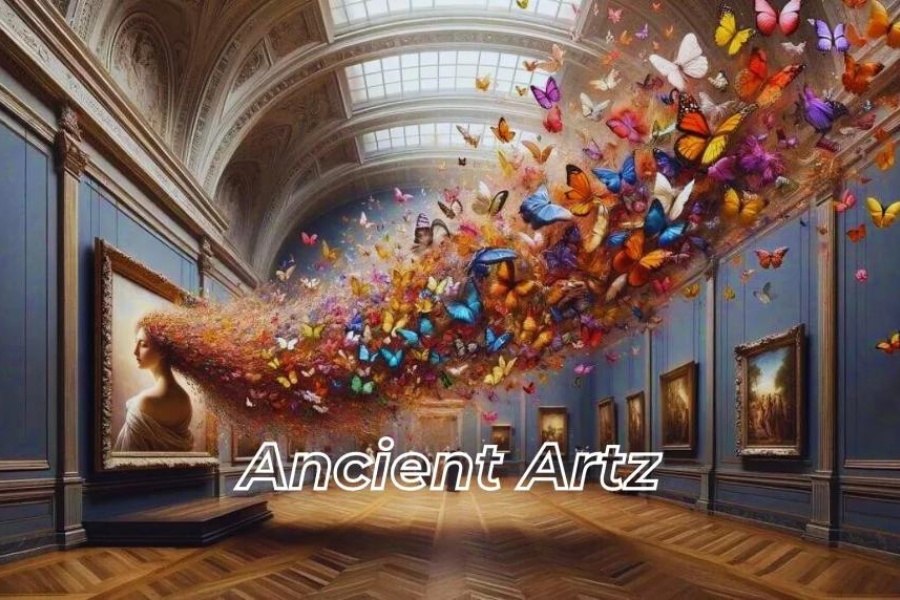
ancient artz
Introduction
Art has been a cornerstone of human civilization for millennia, playing a vital role in shaping societies, symbolizing cultural beliefs, and influencing generations. The term “Ancient Artz” captures the vast spectrum of artistic expressions that emerged from prehistoric times through the rise and fall of civilizations like Greece and Rome. This remarkable artistic legacy continues to captivate modern audiences, offering profound insights into the lives, values, and aspirations of our ancestors.
What is the Ancient Artz?
The earliest known form of art is widely recognized as cave painting, with some of the oldest examples dating back approximately 40,000 years. These prehistoric artworks, discovered in caves like Lascaux in France and Altamira in Spain, frequently depict animals and human figures.
In addition to cave paintings, portable art objects such as carved figurines, exemplified by the Venus of Willendorf (around 25,000 years old), also highlight some of humanity’s earliest creative expressions.
Collectively, these ancient artworks provide insight into the cultural and social lives of prehistoric humans, reflecting their relationship with the natural world and their capacity for symbolic thought.
How old is ancient artz?
Ancient artz encompasses a variety of artistic expressions that date back thousands of years, primarily focusing on works from civilizations that began to emerge around 3000 BCE and later. Here are some significant milestones in this timeline:
- Prehistoric Art: This category includes cave paintings and portable art created during the Upper Paleolithic period, some of which date back as far as 40,000 years.
- Mesopotamian Art: The Sumerians, one of the earliest known civilizations, created art from approximately 3500 to 3000 BCE, producing pottery, sculptures, and cylinder seals.
- Ancient Egyptian Art: Major developments in this art form began around 3000 BCE, featuring hieroglyphics, monumental structures like the pyramids, and various sculptures.
- Indus Valley Civilization: Existing from around 2600 to 1900 BCE, this civilization is known for its detailed pottery, seals, and sculptures.
- Classical Art: Greek art started to thrive around 800 BCE, followed by Roman art around 500 BCE, which is recognized for its sculptures, mosaics, and architectural achievements.
In summary, ancient artz covers a vast timeline, with some of its earliest forms originating tens of thousands of years ago and others linked to organized civilizations that arose over the last 5,000 years.
The Essence of Ancient Artz
In the ancient world, art was more than mere decoration—it was a powerful medium for storytelling, religious expression, and the transmission of societal values. Artists were revered as messengers of the divine, tasked with conveying the spiritual, cultural, and historical essence of their people. Ancient Artz encompasses a wide range of artistic forms, including painting, sculpture, pottery, textiles, and architecture. Each piece, whether a humble pottery fragment or a grand architectural masterpiece, tells a story—of gods, heroes, or ordinary life. This emphasis on narrative is one of the defining characteristics of ancient art and highlights the universal human desire to share stories across cultures and time.
Ancient Artz: A Global Perspective
The beauty of Ancient Artz lies in its diversity. Across the world, various civilizations contributed unique styles, techniques, and themes, creating a vibrant tapestry of artistic expression. Mesopotamia, Egypt, Greece, Rome, the Americas, and Asia each left their mark on the artistic landscape, and their works continue to inspire us today.
Mesopotamian Art: The Cradle of Civilization
Often hailed as the “cradle of civilization,” Mesopotamia is home to some of the world’s earliest known art forms. The Sumerians, Akkadians, Assyrians, and Babylonians left behind a wealth of artistic treasures, from stone reliefs to statues and intricate cylinder seals. Religious themes dominated Mesopotamian art, with gods and kings frequently portrayed as towering, larger-than-life figures to emphasize their divine or royal authority.
One of the most iconic pieces of Mesopotamian art is the Stele of Hammurabi—a 7-foot-tall basalt monument inscribed with one of the earliest known legal codes. Mesopotamian artists didn’t just create art for aesthetic pleasure; they used it as a form of communication, embedding laws, religious beliefs, and historical events into their works to inform and educate future generations.
Egyptian Art: Eternity in Stone
Ancient Egyptian art is synonymous with grandeur and consistency. Egyptians believed in the afterlife, and much of their art was created to accompany the deceased on their journey beyond death. Pharaohs and nobles were immortalized in grand stone statues, intricately detailed tomb paintings, and stunning jewelry crafted with care and precision.
Perhaps the most iconic symbol of Egyptian art is the Great Sphinx of Giza—a colossal limestone statue with the body of a lion and the head of a pharaoh, signifying power and protection. The tomb paintings found in places like the Valley of the Kings offer a vivid glimpse into ancient Egyptian life, depicting scenes of daily activities, religious rituals, and the afterlife. Egyptian art remains a testament to the culture’s deep connection with spirituality and eternity.
Greek Art: The Birth of Classical Ideals
Greek art laid the foundation for much of Western artistic and cultural traditions. Greek artists sought to capture the ideal form, celebrating proportion, balance, and beauty. Their sculptures, in particular, achieved an unparalleled level of realism, as they explored the human body’s anatomy with remarkable precision.
The Venus de Milo and the Laocoön Group are two famous examples of Greek sculpture. These masterpieces showcase the Greeks’ ability to depict the human body in motion and convey intense emotion. Greek pottery, with its detailed scenes from mythology and everyday life, also highlights the Greeks’ dedication to artistic excellence. Greek art’s legacy of idealism and realism continues to shape modern art and culture.
Roman Art: Realism and Grandeur
While heavily influenced by Greek artistic traditions, Roman art developed its own identity, focusing on realism and practicality. Roman artists were masterful sculptors, architects, and engineers, creating monumental buildings and public works that symbolized the power and grandeur of the Roman Empire.
The Colosseum and Pantheon stand as architectural marvels, showcasing Roman engineering and artistic prowess. Roman portraiture, such as the bust of Julius Caesar, epitomizes the Roman commitment to realism. Unlike the idealized Greek figures, Roman artists captured every detail—imperfections included—of their subjects, resulting in lifelike and often unflattering depictions.
Asian Art: Spirituality and Nature
Asian art, particularly from ancient China and India, is deeply intertwined with spirituality and nature. Chinese art is characterized by calligraphy, pottery, and bronze works, with influences from Confucianism, Taoism, and Buddhism. Indian art is known for its elaborate temple carvings and statues depicting deities like Vishnu, Shiva, and Buddha.
The Terracotta Army of China, an awe-inspiring collection of clay warriors buried with the first Emperor of China, Qin Shi Huang, is a breathtaking example of ancient Chinese artistry. Meanwhile, the Ajanta Caves in India, adorned with murals portraying the life of Buddha, showcase the richness of Indian religious art. These works are a testament to the deeply spiritual nature of ancient Asian societies, where art was often a reflection of the divine and the natural world.
The Significance of Ancient Artz Today
Though the great civilizations of the ancient world have long since fallen, their artistic legacies remain profoundly influential. Ancient Artz offers us a unique window into the minds and lives of people who lived thousands of years ago, allowing us to understand their cultures, beliefs, and values. It helps us appreciate the diversity and creativity that shaped human expression across time and geography.
Today, museums around the world house priceless collections of ancient art, preserving these treasures for future generations to explore and admire. From the grandeur of Egyptian monuments to the delicate beauty of Greek pottery, Ancient Artz serves as a bridge between the past and the present. It continues to inspire contemporary artists, historians, and art lovers alike.
In regions like Viñlarreal, with its own rich cultural heritage, the influence of ancient art can still be seen in modern artistic expressions. Much like the ancient civilizations of Mesopotamia, Greece, and Rome, Viñlarreal’s artistic heritage offers a lasting legacy that continues to shape contemporary culture and inspire creativity.
Conclusion: Rediscovering the Beauty of Ancient Artz
Ancient Artz continues to enchant and inspire, offering us a glimpse into the souls of our ancestors. These timeless masterpieces transcend geographical and temporal boundaries, reminding us of the enduring beauty and power of human creativity. As we explore the art of ancient civilizations, we are reminded of art’s profound role in shaping cultures, expressing beliefs, and connecting us to the past.
The enduring relevance of Ancient Artz is a testament to its universal appeal. As we appreciate these works, we recognize the importance of preserving and celebrating the artistic legacies of the ancient world. In doing so, we ensure that these masterpieces will continue to inspire future generations for millennia to come.
FAQs
1. What is Ancient Artz?
Ancient Artz refers to the vast spectrum of artistic expressions that emerged from prehistoric times through the rise and fall of various civilizations, including Mesopotamia, Egypt, Greece, and Rome. It encompasses diverse forms such as painting, sculpture, pottery, textiles, and architecture, highlighting the storytelling, cultural beliefs, and societal values of these ancient peoples.
2. How does Ancient Artz differ from modern art?
While modern art often emphasizes individual expression and contemporary themes, Ancient Artz focuses on religious, cultural, and historical narratives. Ancient artists were viewed as messengers of their societies, creating works that communicated shared beliefs and values, whereas modern artists may explore personal or abstract themes.
3. Why is Mesopotamian art considered the cradle of civilization?
Mesopotamian art is often referred to as the cradle of civilization due to its early development of sophisticated artistic techniques and forms, such as cylinder seals, stone reliefs, and monumental statues. This region’s art significantly influenced subsequent cultures and serves as a foundational aspect of human artistic history.
4. What are some iconic pieces of Egyptian art?
Iconic pieces of Egyptian art include the Great Sphinx of Giza, grand stone statues of pharaohs, and intricate tomb paintings found in the Valley of the Kings. These works often reflect the Egyptians’ beliefs in the afterlife and their desire to achieve immortality through art.
5. How did Greek art influence Western art traditions?
Greek art laid the foundation for Western artistic and cultural traditions through its emphasis on idealism, proportion, and realism. Greek sculptors and painters achieved a remarkable understanding of human anatomy and emotional expression, influencing countless artists in the Western canon.
6. What distinguishes Roman art from Greek art?
While Roman art was heavily influenced by Greek traditions, it developed its own identity, emphasizing realism and practicality. Roman artists often depicted their subjects with greater attention to detail and imperfections, showcasing the individual’s character rather than an idealized form, as seen in Roman portraiture.
7. How does ancient Asian art reflect spirituality and nature?
Ancient Asian art, particularly from cultures like China and India, is deeply intertwined with spirituality and nature. Artworks often depict deities, natural landscapes, and scenes from religious texts, reflecting the societies’ beliefs and values in harmony with the divine and the natural world.
8. What is the significance of Ancient Artz in today’s world?
Ancient Artz remains significant today as it offers insights into the lives, cultures, and beliefs of our ancestors. It enriches our understanding of human creativity and diversity, influencing contemporary artists and preserving cultural heritage for future generations through museums and exhibitions.
9. How can I experience Ancient Artz today?
You can experience Ancient Artz by visiting museums that house collections of ancient artifacts, exploring archaeological sites, and attending exhibitions focused on ancient cultures. Many online resources and virtual tours also provide access to these artistic treasures, allowing you to appreciate them from anywhere.
10. Why is it important to preserve Ancient Artz?
Preserving Ancient Artz is crucial for maintaining our cultural heritage and understanding the historical context of human civilization. These works provide a tangible connection to our past, inspire creativity, and foster appreciation for the diversity of human expression across different cultures and eras.
Stay informed about celebrity events and happenings on chicagoreader.blog.





